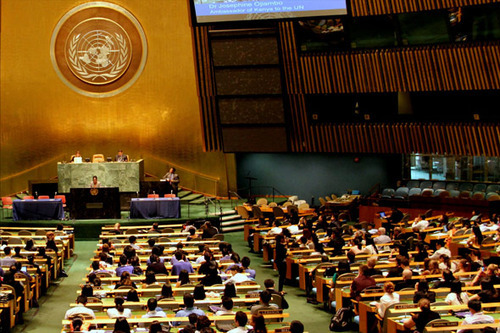 members of the UN sit and discuss
members of the UN sit and discuss
We’re Tired of the Kids Table
By Erik Lampmann
Institutions dedicated to the pursuit of the ‘common good’ will be unable to forge meaningful coalitions, strategize policy interventions, or leverage communities’ collective voices without integrated youth at argue youth at the highest levels of spaces invested with real decision-making power; this applies even to that most storied institution of collaboration, the United Nations.
A full one billion people fall into the category of 15-24 year olds. Our generation is one of the most diverse in human history. We’re polyglot, multicultural, and are connecting with each other across oceans, continents, and time zones. We’ve come of age during a lynchpin movement for the climate justice movement, beneftted from the gains of the LGBTQ+ rights movement, and are ourselves struggling against the specter of the worst economic crisis since the Great Depression.
Any way you spin it, our generation is facing social, economic, political, and ecological hurdles previously unknown. We’re expected to curb decades long bouts of inaction to mitigate the effects of climate change, find some semblance of balance in a chaotic global economic system, and find beauty in the cacophony of our 6 billion voices.
Two weeks ago I had the privilege of spending time with 15 change-agents – 15 American youth who united with one voice in their demand for increased representation in the halls of government, both nationally and internationally.
Working with an American NGO, SustainUS, a youth-organized effort to increase our generation’s representation in international governance spaces, we advocated for a multidimensional policy platform at the 52nd United Nations Commission on Social Development.
It might sound empowering to be in a space so given to the diversity of the human experience. Yet, as many of us learned, many United Nations and the international state system is loath to admit a serious flaw in their understanding of how change happens: the necessity of intergenerational leadership.
The continued underrepresentation of the youth community is not only unjust – it’s strategically unwise given the power landscape of the coming decades, creates leadership gaps, skill mismatches, and unsustainable leadership structures. In fact, many youth change-agents would like nothing else than to engage in intergenerational work that isn’t consigned to continuously remake the wheel each time a new class of organizers graduate college.
Meaningful progress has been made by UN entities and member-states in the past. In December 2012, the UN Population Fund convened the Bali Global Youth Forum to review the Programme of Action of the International Conference on Population and Development Beyond 2014. The frameworks generated by the youth present (as well as thousands of youth delegates participating virtually) were quite progressive and focused a good deal of attention on the sexual and reproductive rights of all youth, including those traditionally marginalized by service providers.
From 2003 to 2005, the government of South Africa included a massive civic society engagement program to facilitate the development of a new Children’s Act that included consultations with children using accessible language and having provided appropriate legislative training.
Some Western European countries have even gone further and established new ‘youth delegate’ positions elected by popular vote. Youth delegates currently represent youth constituencies of countries like Germany, the Netherlands, Romania, Bulgaria, and Belgium with real decision-making power.
As these examples demonstrate, youth are sometimes present in policy-making spaces at the national and international level. There have certainly been occasions where members of the political class decided to include young people in a specific debate. Yet, the systemic validation of youth voices remains lacking in UN spaces. We are too often relegated to ‘side-events,’ NGO speakers’ lists treated only at the end of any formal session, and tokenized by moderators seeking a brief interlude between ambassador’s diatribes. As the world’s premier organization dedicated to building sustainable, resilient democratic spaces, the UN can and must do more in the coming months, years, and decades.
To begin, 2014 will see continued work across the UN system to articulate the Post-2015 Development Agenda, the successor to the Millennium Development Goals (MDGs). Additionally, Secretary Ban Ki-Moon continues plans to scale up his plans for a new Partnerships Facility to build the capacity of NGOs working in concert with various UN agencies, programs, and funds. Given the increasing severity of the global climate crisis, attention will also go to the development of additional Sustainable Development Goals (SDGs) alongside the Secretary General’s “Sustainable Energy for All” Initiative. It’s in these conversations that SustainUS and other youth delegations will look to the UN to center the voices of youth and those directly impacted by policy shortcomings.
All in all, there are a host of impactful policy and framework discussions to come in the next twelve months which have the potential to impact international development practices for years to come. The silo of the youth movement prevents us from leveraging our potential most effectively to address these issues. In short, we’re tired of the kids table; what we need – and what you need – is for us to be at each and every table, fully integrated into the meaningful struggles to leverage our collective, intergenerational power to confront the world’s social ills.
This article was originally published on Sustain US: US Youth for Sustainable Development.
Erik Lampmann
Outside of my activism and academic scholarship, Erik enjoys loose-leaf tea, the “West Wing,” and vegetarian cooking.
Catch up with me @eriklampmann.

